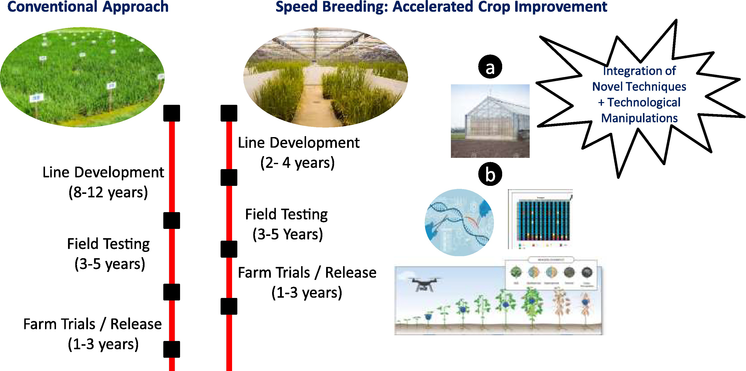Speed Breeding and Its Implications for Crop Improvement
Mitali Tiwari* and Akhouri Nishant Bhanu
July 16th 2025, 11:02:21 am | 5 min read

Introduction
In the present scenario of global climate change, the increase in food production levels is not at a pace to meet the hunger needs of the ever-rising population. Agricultural scientists and plant breeders are under perpetual pressure to equip the present crop varieties for crop resilience to get higher yields. Through their efforts by applying a surfeit of conventional and modern techniques, breeders are able to push up the yield bar. Though plant breeders are successful in designing varieties for climate change, the major limiting factor that hinders the progress of plant breeding is the time consumed in designing a variety. In the present scenario where, immediate attention has to be given for accelerated improvement, combining conventional methods will underpin efforts to meet the challenge of feeding the population of nearly 10 billion. Speed breeding involves the manipulation of environmental conditions under which crop genotypes are grown aiming to accelerate flowering and seed set, for the rapid advancement of generations that saves a lot of time and resources. Various breeding methods can be easily complemented with speed breeding such as single seed descent (SSD), single plant selection (SPS), clonal selection, and marker-assisted selection (MAS) genomic selection. Therefore, speed breeding offers opportunities to rapidly develop stable varieties and to facilitate rapid generation advancement thereby accelerating the breeding program. Also, speed breeding technology fits well with MAS and high-throughput phenotyping methodologies for multiple trait selection.

Figure: Rapid generation advancement through speed breeding (Source: Wang, 2022)
The general procedure of Speed Breeding
1. A room with insulated sandwich paneling outfitted with seven LED light boxes (one light box every 0.65m2) and a 1.5 horsepower inverter split system household air conditioner can be utilized as an alternative to the commonly used Conviron BDW chamber.
2. At bench height, the PAR light amount should be between 210 and 260 mol/m2s1, and at 50 cm above the pot, between 340 and 590 mol/m2s1. 140 cm above the bench is the ideal height for the lights to be placed. The space should be large enough to hold 90 pots of 20.3 cm.
3. The use of an irrigation controller with one solenoid per room and one spike dripper per 20.3 cm pot will enable automatic watering.
4. Ambient humidity levels are ideal.
5. The blue, red, and far-red portions of the spectrum should be enhanced in the illumination. For four weeks, it should be set at a 12-hour photoperiod and 12-hour darkness, and then gradually raised to an 18-hour photoperiod and 6-hour darkness.
6. One option for controlling temperature is to set an air conditioner at 21°C during the day and 8°C at night.

Temperature-controlled glasshouses with supplemental lighting consisting of LEDs. (Source: www.plantekno.com; www.jic.ac.uk)
Limitations
i. Needs expertise and technical skill to carry out a speed breeding program.
ii. Require proper infrastructure, and plant phenomics lab facility.
iii. Establishment needs long-term financial funding and support.
iv. Response of different plant species varies to extended photoperiods, especially the case with day-neutral plants, in which flowering will occur regardless of the photoperiod.
v. In crops where photoperiod response is unknown or complex in nature, prior experimentation is required to standardize the protocol.
vi. Establishment of the greenhouse with all the lighting and temperature requirements is a costly affair.
Conclusion
Speed breeding can effectively and efficiently accelerate the breeding cycle and aids in the rapid development of improved cultivars to cater to the emerging needs of the ever-rising population. Recent advancements in breeding techniques like genetic engineering, genomic selection, and doubled-haploid technology have shortened breeding cycles and enhanced genetic gain rates. Speed breeding strategies are highly amenable to other breeding methods. When these technologies are paired with speed breeding techniques can enhance the effectiveness of breeding programs. However, speed breeding is not widely adopted by many developing countries because of its highly demanding nature for infrastructural facilities, trained breeders, and financial needs. Financial aids/backup for speed breeding programs in public plant breeding institutes would aid in sustaining the method usage and accelerating the pace of breeding accomplishments for ensuring food security.
References
Bhatta, M., Sandro, P., Smith, M. R., Delaney, O., Voss-Fels, K. P., Gutierrez, L., & Hickey, L. T. (2021). Need for Speed: manipulating plant growth to accelerate breeding cycles. Current Opinion in Plant Biology, 60, 101986.
Gerald, N. D. L. F., Frei, U. K., & Lübberstedt, T. (2013). Accelerating plant breeding. Trends in Plant Science, 18(12), 667-672. doi: 10.1016/j.tplants.2013.09.001
Wanga, M. A., Shimelis, H., Mashilo, J., & Laing, M. D. (2021). Opportunities and challenges of speed breeding: A review. Plant Breeding, 140(2), 185-194